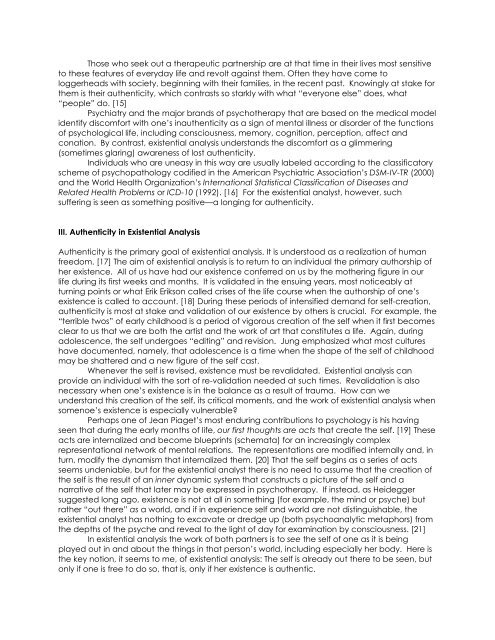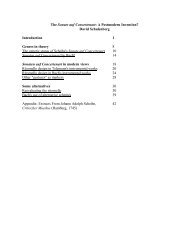SEVEN PAPERS ON EXISTENTIAL ANALYSIS ... - Wagner College
SEVEN PAPERS ON EXISTENTIAL ANALYSIS ... - Wagner College
SEVEN PAPERS ON EXISTENTIAL ANALYSIS ... - Wagner College
You also want an ePaper? Increase the reach of your titles
YUMPU automatically turns print PDFs into web optimized ePapers that Google loves.
Those who seek out a therapeutic partnership are at that time in their lives most sensitive<br />
to these features of everyday life and revolt against them. Often they have come to<br />
loggerheads with society, beginning with their families, in the recent past. Knowingly at stake for<br />
them is their authenticity, which contrasts so starkly with what “everyone else” does, what<br />
“people” do. [15]<br />
Psychiatry and the major brands of psychotherapy that are based on the medical model<br />
identify discomfort with one’s inauthenticity as a sign of mental illness or disorder of the functions<br />
of psychological life, including consciousness, memory, cognition, perception, affect and<br />
conation. By contrast, existential analysis understands the discomfort as a glimmering<br />
(sometimes glaring) awareness of lost authenticity.<br />
Individuals who are uneasy in this way are usually labeled according to the classificatory<br />
scheme of psychopathology codified in the American Psychiatric Association’s DSM-IV-TR (2000)<br />
and the World Health Organization’s International Statistical Classification of Diseases and<br />
Related Health Problems or ICD-10 (1992). [16] For the existential analyst, however, such<br />
suffering is seen as something positive—a longing for authenticity.<br />
III. Authenticity in Existential Analysis<br />
Authenticity is the primary goal of existential analysis. It is understood as a realization of human<br />
freedom. [17] The aim of existential analysis is to return to an individual the primary authorship of<br />
her existence. All of us have had our existence conferred on us by the mothering figure in our<br />
life during its first weeks and months. It is validated in the ensuing years, most noticeably at<br />
turning points or what Erik Erikson called crises of the life course when the authorship of one’s<br />
existence is called to account. [18] During these periods of intensified demand for self-creation,<br />
authenticity is most at stake and validation of our existence by others is crucial. For example, the<br />
“terrible twos” of early childhood is a period of vigorous creation of the self when it first becomes<br />
clear to us that we are both the artist and the work of art that constitutes a life. Again, during<br />
adolescence, the self undergoes “editing” and revision. Jung emphasized what most cultures<br />
have documented, namely, that adolescence is a time when the shape of the self of childhood<br />
may be shattered and a new figure of the self cast.<br />
Whenever the self is revised, existence must be revalidated. Existential analysis can<br />
provide an individual with the sort of re-validation needed at such times. Revalidation is also<br />
necessary when one’s existence is in the balance as a result of trauma. How can we<br />
understand this creation of the self, its critical moments, and the work of existential analysis when<br />
somenoe’s existence is especially vulnerable?<br />
Perhaps one of Jean Piaget’s most enduring contributions to psychology is his having<br />
seen that during the early months of life, our first thoughts are acts that create the self. [19] These<br />
acts are internalized and become blueprints (schemata) for an increasingly complex<br />
representational network of mental relations. The representations are modified internally and, in<br />
turn, modify the dynamism that internalized them. [20] That the self begins as a series of acts<br />
seems undeniable, but for the existential analyst there is no need to assume that the creation of<br />
the self is the result of an inner dynamic system that constructs a picture of the self and a<br />
narrative of the self that later may be expressed in psychotherapy. If instead, as Heidegger<br />
suggested long ago, existence is not at all in something (for example, the mind or psyche) but<br />
rather “out there” as a world, and if in experience self and world are not distinguishable, the<br />
existential analyst has nothing to excavate or dredge up (both psychoanalytic metaphors) from<br />
the depths of the psyche and reveal to the light of day for examination by consciousness. [21]<br />
In existential analysis the work of both partners is to see the self of one as it is being<br />
played out in and about the things in that person’s world, including especially her body. Here is<br />
the key notion, it seems to me, of existential analysis: The self is already out there to be seen, but<br />
only if one is free to do so, that is, only if her existence is authentic.















